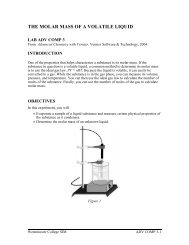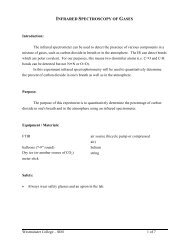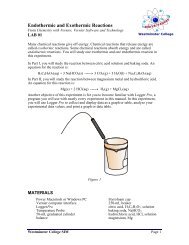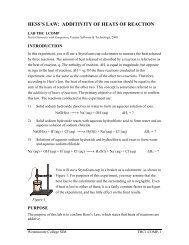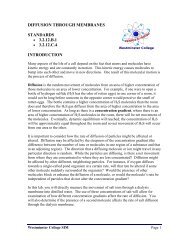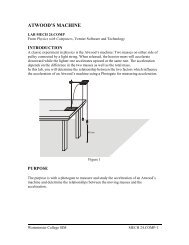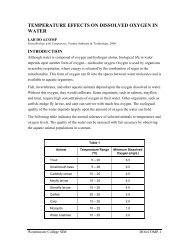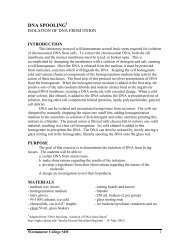Chapter 6 - Marine Vertebrates
Chapter 6 - Marine Vertebrates
Chapter 6 - Marine Vertebrates
You also want an ePaper? Increase the reach of your titles
YUMPU automatically turns print PDFs into web optimized ePapers that Google loves.
<strong>Chapter</strong> 6 - <strong>Marine</strong> <strong>Vertebrates</strong><strong>Chapter</strong> Summary<strong>Vertebrates</strong> occupy all marine habitats and are important players in nearly all marine food webs.All living vertebrates, with the exception of hagfishes, osmoregulate in that they spend molecularenergy to maintain a relatively constant internal concentration of solutes. The vertebrates in theocean include fishes, reptiles, birds, and mammals, with the fishes being the most successful interms of numbers of species (about 50% of living vertebrates) and numbers of individuals.The most primitive marine fishes are the jawless Agnathans. These fishes are not closely related,and are distinguished from other vertebrates in that they lack jaws, paired fins, and scales.Hagfishes are marine, benthic scavengers that give birth to live young and possess unique slimeglands, whereas lampreys are oviparous, anadromous creatures that often parasitize teleosts asadults. The second major group of fishes is the cartilaginous fishes, or the sharks, rays, and thelesser-known chimaeras. The Chondrichthyes are mostly marine fishes that often grow to largesizes, retain metabolic wastes (urea and TMAO) to achieve osmotic equilibrium with seawater,and possess a heterocercal caudal fin. Chondrichthyans reproduce via internal fertilization andpossess internal embryos that develop inside egg cases that are deposited in the environment orare born live after completing their development inside their mothers, both with and without thebenefit of a placental attachment to her blood supply. The third major group of fishes is the bonyfishes. These animals have mineralized skeletons, complex osmoregulatory mechanisms, andswim bladders as a buoyancy mechanism. The bony fishes have been extremely successful interms of their ability to diversify and are now found in virtually all marine and freshwaterhabitats.<strong>Marine</strong> tetrapods are represented by the reptiles, birds, and mammals, with birds andmammals being the most successful. About 100 species of sea snakes, 7 species of sea turtles,and one representative each of iguana and crocodile are truly marine (other reptiles areestuarine). All marine reptiles, and the closely related sea birds, eliminate excess salts via theirkidneys and specialized salt glands contained in their mouths, nostrils, or orbits. "<strong>Marine</strong>" birdsrange from those that are nearly full-time residents of the sea, such as penguins, to other speciesthat simply visit the shoreline to feed, such as some ducks, geese, and coots. Beinghomeothermic and living in or near a cold, dense medium necessitates the development of a widevariety of thermoregulatory adaptations, including streamlined bodies, primary propulsionmuscles being located in their torso, a dense covering of feathers and blubber, and countercurrentvasculature in feet and wings.<strong>Marine</strong> mammals are represented by three orders; Carnivora (seals, sea lions, walruses, seaotters, and polar bears), Sirenia (manatees, dugongs, and sea cows) and Cetacea (whales,dolphins, and porpoises). <strong>Marine</strong> mammals differ from their terrestrial ancestors in terms ofmany physiologic, anatomic, and behavioral adaptations. Two major adaptations includemechanisms to deal with extreme heat loss and the ability to exist in an aquatic environment asair breathers.Oxygen acquisition can be a challenge in the ocean, especially for air-breathing marinemammals. Two adaptations accommodate oxygen uptake in marine mammals; apneusticbreathing and extensive elastic tissues in the lungs and diaphragm. To accommodate diving inmarine mammals, other physiologic mechanisms have evolved such as bradycardia, the slowingof the heart rate.
Most marine vertebrates possess the standard five sensory systems of vision, touch, taste,hearing, and smell, although they favor different systems relative to their terrestrial relatives(vision is of little use under water) and even possess additional sensory systems that are onlyuseful in water (such as electroreception). Chemoreception is very important to marine fishes,and they may possess some of the most sensitive noses of any animal, but tetrapods all closetheir nostrils while under water and therefore rely on their sense of smell very little. The abilityto detect weak electric and electromagnetic fields has been demonstrated in bacteria,cartilaginous and bony fishes, some birds, and possibly some whales. Aquatic vision requiresalterations to terrestrial visual systems to compensate for the in the quality and quantity of lightavailable under water, such that marine vertebrates focus by moving the lens within the eye(rather than changing its shape), and detect light with altered ratios of photoreceptor cells andunique visual pigments. Most marine vertebrates can hear, and they use anatomical systems thatare very similar to those seen in terrestrial species. Nevertheless, they need to compensate forthe fact that sound travels about fives times more rapidly under water, and often change the routeby which sound travels on its way to the sensory hair cells in their cochlea.http://bioscience.jbpub.com/marinebiology/outlines/<strong>Chapter</strong>_06_Outline.rtf




